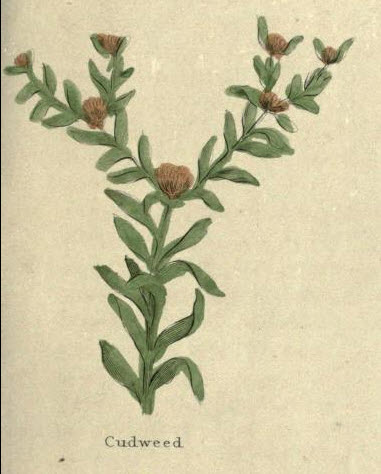
CUDWEED, OR COTTONWEED.
Cudweed Description:Gnaphalium. It is also called Chaffweed, Dwarf Cotton, and Petty Cotton. The common Cudweed rises up with one stalk, and sometimes with two or three, thick set on all sides with small, long, whitish, and woody leaves, from the middle of the stalk almost to the top; with each leaf is a small flower of a brownish yellow colour; after the flowers are fallen, come small seed wrapped up, with the down therein, which is carried away with the wind; the root is small and thready.There are smaller kinds of this plant, the flowers paler, and more open. They grow in dry, barren, sandy, and gravelly grounds. They flower about July, and their seed is ripe in August. Herbal Remedies and Medicinal Uses of Cudweed:The plants are all astringent, binding or drying, and therefore profitable for defluxions of rheum from the head, and to stay the fluxes of blood. The decoction being made in red wine, or the powder may be taken. It is very useful in dysentery, and for the immoderate courses of women, and for inward or outward wounds, hurts, or bruises. It expels worms in children, and as a decoction or as an injection, it removes the disease called Tenesmus, or a feeling for evacuation without doing anything. The green leaves bruised, and laid to any green wound, stays the bleeding, and heals it quickly. The juice of the herb taken in wine and milk, is, as Pliny says, a sovereign remedy for the quinsy.
Important Disclaimer:
The information contained on this web site is for educational purposes
only. It is not intended to diagnose, treat, or cure any diseases. Any
information presented is not a substitute for professional medical advice
and should not take the place of any prescribed medication. Please do not
use this information to diagnose or treat a health problem or disease
without consultation with your physician.
This page and the rest of the encyclopedia of medicinal herbs was reproduced from old herbals written in the 1700 and 1800s. They are of historical interest to show the traditional uses of various herbs based on folk medicine and ancient wisdom. However the traditional uses for these herbs have not been confirmed by medical science and in some cases may actually be dangerous. Do not use the these herbs for any use, medicinal or otherwise, without first consulting a qualified doctor. Browse Herbs Alphabetically: A B C D E F G H I J K L M N O P Q R S T U V W X Y Z |
Advertisement
|
||
|
|||